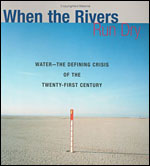
After reading a few things — namely this from Ezra Klein, this from Brad Plumer, and a Prospect article by Jon Margolis — I resolved to learn more about the world’s water woes. After all, I’m already a giant energy nerd, so why not become a giant water nerd?
Perhaps I should lose some weight, and be a more modestly-sized nerd. In any case, number one on my reading list was When the Rivers Run Dry by Fred Pearce. Read the Salon review here.
The one-word review of Pearce’s book is: Terrifying. Whether he’s writing about the Indian peasant farmers who draw from poisoned wells every day, the oblivious Arizonans who run fountains in the desert, or the apocalyptic moonscape that is the Aral Sea (once a thriving fishery, now a toxic cesspool), Pearce manages to convey the immense wreckage human activity is making of our lifeblood. No, not oil. The other precious fluid.
I think a lot of people have a hard time imagining that human activity really can have such a profound effect, but this book should be an antidote to that. We’ve all probably met someone who refused to believe that anthropogenic CO2 could really be responsible for so many problems. This book manages to convey clearly and starkly the effects we’ve had on rivers and lakes all over the world.
Some examples: The Rio Grande now ceases to exist shortly after is passes El Paso, only to be reborn from a tributary closer to the sea. The Colorado no longer makes it all the way to the Pacific, destroying the habitat of numerous species who thrived in that river’s delta. And the Yellow River — the foundation of Chinese civilization, their version of the Nile — now barely makes it to the coastal province of Shandong, the birthplace of Confucius. In response, the Chinese are building what will probably amount to the largest water diversion in human history to pipe water from the Yangtze to the North.
But the chapter on the Aral Sea — or more properly, its rotting corpse — is simply bone-chilling. After the two main rivers that fed the Aral were diverted to grow cotton in the desert, the Aral rapidly began losing area and became more saline and more clogged with fertilizers and pesticides. The salt that is left on the old shorelines is eventually whipped up in dust storms, getting everywhere. The constant salt exposure gives the Aral Sea residents the highest rate of anemia in the world — in some places, 90% of the children are anemic. Some fishing towns haven’t seen water in decades.
What’s especially troubling is cases like the Colorado or the Rio Grande where every last drop is spoken for, because changes in one area of the river can have multiple effects downstream and up. Sometimes, even conservation isn’t the answer, bizarrely enough.
One particularly interesting part of the book deals with the legacy of massive hydropower dams, and how ineffective they’ve been at using water or spurring development in the Third World. Even more ironic, Pearce looks at the surface area that is taken up for the large reservoirs necessary for these dams, and calculates that the “power density” is around a kilowatt per hectare — far, far worse than solar or wind.
Like all good eco-tomes, When The Rivers Run Dry ends on some positive notes — emphasizing that there are solutions to many of these problems. The question is whether we are willing to abandon what RFK Jr. (when he isn’t torpedoing wind farms) calls the Dominion Heresy: That the Earth is ours to control, define, and master.



